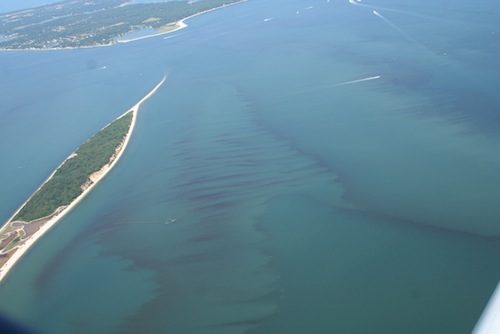Rust tide is back in the Peconic Estuary for the 10th consecutive season, and while so far the toxic algae doesn’t seem to be having the devastating effect on marine life it had last year, researchers studying the algae blooms say it has pushed far to the east of where it was originally recorded.
“We first noted it in the western part of the Peconic in the middle of August, and we’ve been tracking it ever since then,” said Christopher Gobler, a professor at Stony Brook University’s School of Marine and Atmospheric Sciences.
“Each week thereafter it expanded from just tributaries to Flanders Bay, into Great Peconic Bay, into Little Peconic Bay, into Noyak Bay, and then all the way out into Shelter Island Sound. We’ve seen it all the way into East Hampton, places like Three Mile Harbor.”
The algae, or Cochlodinium polykrikoides, is patchy, appearing in different locations and spreading out vertically and horizontally. Gobler said the manner in which it spreads is not clear, but blooms have been more intense in density and number than when rust tide was first discovered in the region in 2004. This type of algae was first documented in the Caribbean 20 years ago and has since appeared on both U.S. coasts and in Europe and Asia.
“The concern is that it does have negative effects on fisheries,” Gobler said, noting that much effort was put into rebuilding local scallop fisheries before scallop populations collapsed last year, when bay scallop densities in the Peconic Estuary declined tenfold in some regions during the rust tide.
Fish that are trapped in catches die from exposure, and many others leave the area, fishermen report.
“It’s toxic to marine life, but humans don’t get sick if they eat any seafood that’s come into contact with it, so that’s good news,” said Gobler.
Peconic Baykeeper Kevin McAllister said he understands the problem to be a long-term one that threatens underwater organisms all the way up the food chain.
“You can’t see a foot below the surface,” he said of areas with blooms. With little or no light penetration, important plants begin to die off from lack of photosynthesis, he said, and their decomposition uses oxygen, stressing all life and forcing fish to flee.
McAllister and Gobler both said excessive nitrogen is the most obvious culprit, with blooms intensifying when high levels are present. McAllister said development in the 1960s and 1970s could be to blame. Aging brick septic tanks experiencing a slow seep could mean decades more of the unwelcome groundwater additives.
“We’re at a tipping point. Toxins are now at levels where water quality is affected,” said McAllister.
He said that storm water runoff is more immediate, sweeping nitrogen from fertilizer and wastewater-tainted groundwater into the bay.
Gobler said the importance of research is to give officials the information they need to make policy decisions that can have an impact.
In the last year, researchers have made two important new discoveries that help explain the chronic recurrence of these events, Gobler said.
“First, we have discovered the organism makes cysts or seeds which wait at the bottom of the bay and emerge each summer to start a new bloom. At the end of the bloom, they turn back into cysts and settle back to the bay bottom. This allows for the blooms to return every year. Second, we have found that nitrogen loading makes these blooms more intense and more toxic. As nitrogen loading has increased into our bays, these events have intensified.”
The rust tide typically extends into the fall or until water temperatures drop below 60 degrees.

Photos of rust tide in Peconic Estuary in August 2010 courtesy of Peconic Baykeeper
The survival of local journalism depends on your support.
We are a small family-owned operation. You rely on us to stay informed, and we depend on you to make our work possible. Just a few dollars can help us continue to bring this important service to our community.
Support RiverheadLOCAL today.

































